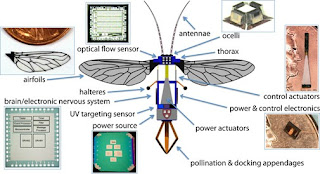This RoboBees are collaborating investigators at Harvard University School of Engineering and Applied Sciences, the Wyss Institute for Biologically Inspired Engineering and CentEy.
This project integrates approaches at the body, brain and colony level. Inspired by the biology of a bee and the insectÕs hive behavior, we aim to push advances in miniature robotics and the design of compact high-energy power sources; spur innovations in ultra-low-power computing and electronic " smart " sensors; and refine coordination algorithms to manage multiple, independent machines.
Anatomy of the Robobee
- Brain: Simple circuits handle basic functions, including balance and hovering. A microprocessor runs the bee’s high-level functions, such as processing data from sensors.
- Eyes: Ultraviolet sensors scan for natural UV patterns on flowers. Digital cameras track objects below the bee to determine how fast and far it’s flying. Light sensors follow the sun to tell if the bee is flying north or south.
- Wings: An actuator flaps two lightweight carbon-fiber wings.
- Antennae: The antennae beam data between bees and could act like whiskers to prevent the ’bot from bumping into things.
- Feet: In the hive, three pronged feet lock the bee into a docking station to recharge its micro fuel cell and upload sensor data to a computer. The feet could also help grab pollen from flowers. Graham Murdoch
How RoboBees Pollinate an Orchard
STEP 1: Establish Home BaseA farmer sets up a mobile RoboBee “hive.” In the future, an autonomous robot could haul the hive from field to field.
STEP 2: Survey the Landscape
Scout RoboBees leave the hive first and use their ultraviolet sensors to locate the same UV patterns on flower petals that real bees look for. Cameras on the bee’s head record landmarks underneath the bee to give it a sense of where and how far it has traveled.
STEP 3: Make a Map
The scouts return to the hive to recharge and upload flower locations to a central computer, which maps the entire orchard as more scouts report in.
STEP 4: Get Pollinating
Worker bees, outfitted with fewer sensors and bigger batteries for longer trips, head directly for the flowers, picking up pollen from one and delivering it to others.

